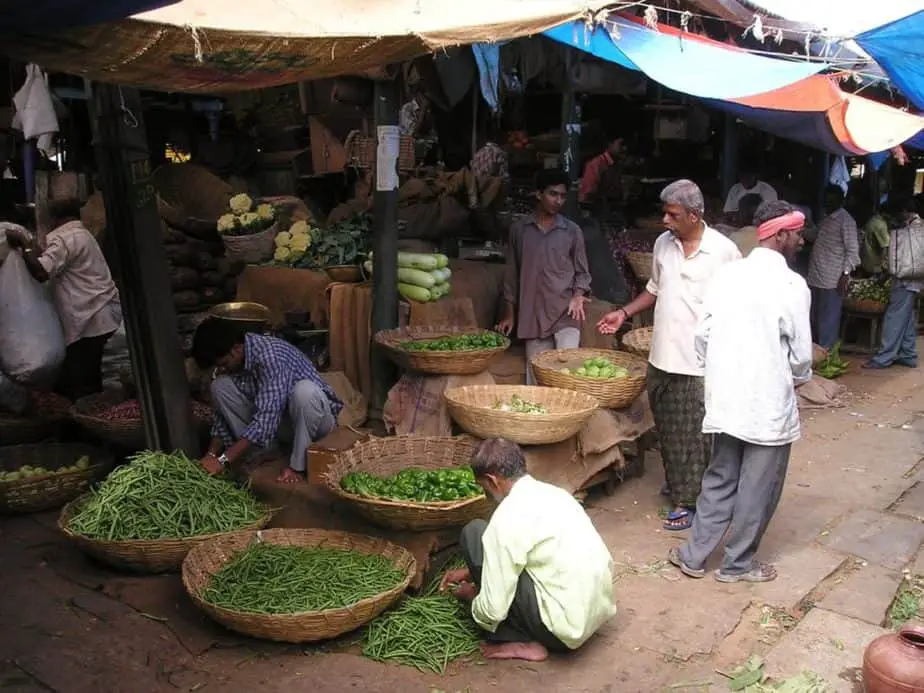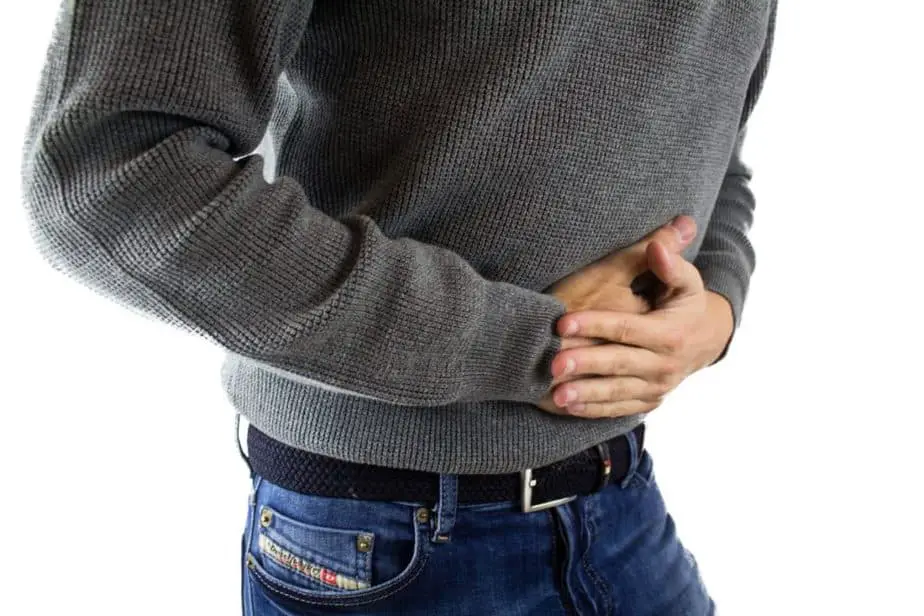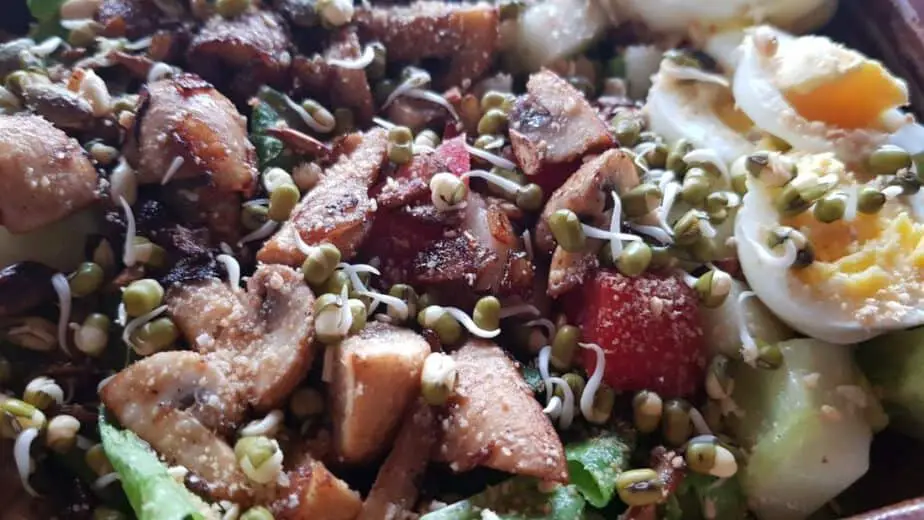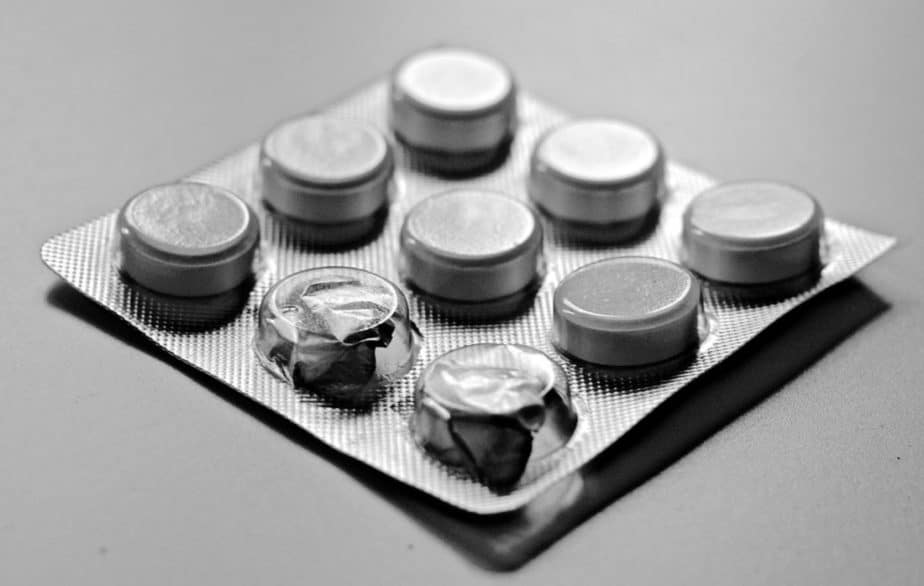I miss salad. I’ve been in India for almost a year and I don’t eat a lot of salads anymore. One main reason is that it is hard to find leafy vegetables where I’m staying. Another reason is that eating raw vegetables in India could be risky, so is it work the risk?
Eating raw vegetables in India is safe if you… Peel it, boil it, or avoid it. This is a general rule to avoid food-related illnesses. Also, wash your own vegetables with a 1% baking soda solution. Or try salads at highly-rated hotels and restaurants.
I used to eat salads 3 to 4 times a day before flying to India. I’d have some spring mix or spinach with breakfast even. I liked how it made me feel – energized and healthy and clear. Recently, I realized though I’d been in India for ~10 months and had never eaten a salad. So I vowed to change that and that’s when I started researching this post.
What I found was discouraging because it may NOT be worth the risk to eat raw vegetables here. But I’ll show you what I found and let you make your own decision 😎
What Are The Risks of Eating Raw Vegetables in India?

I love me some raw vegetables. One time for fun, I did a raw food diet for one month and it was eye-opening. Do you know that post-meal sleepiness you might feel after eating? I never had any of that. I was able to eat, stay energized, and keep working or having fun. [I did miss coffee and cheese though, so that diet’s out ;)]
If you’re planning a trip to India though, you may have read the common advice:
Never eat salads in India, or you will die a terrible terrible death.
-Everyone online
Haha, not quite, but it is one thing that travelers often mention in their typical travel tips for India.
As I’ve been researching this post, there are some very real risks in eating raw vegetables in India:
- Pesticides and insecticides are used heavily: Have you seen the ants in India? They’re like small dogs 😉 I can only imagine what they would do to a crop of lettuce. I have seen men wearing backpacks and spraying fields with chemicals that do NOT smell good at all.
- Fertilizers are commonly used: Life in India for many farmers is a struggle to survive. Using fertilizers to get bigger crops in less time seems like it would have a lot of incentives.
- Microbes and bacteria: Salmonella and E. coli outbreaks have been caused by eating raw vegetables and fruits.
I should add that these risks are NOT exclusive to India.
In many countries, it is common practice to cook vegetables before eating them. And in the USA, there are studies showing that the common use of pesticides, insecticides and fertilizers in farming. People have also gotten sick from eating bacteria on raw vegetables.
What Are the Consequences of Eating Contaminated Vegetables?

The most common consequence you might face is that you’re going to get Delhi Belly or traveler’s diarrhea.
Traveler’s diarrhea is often defined as 3 to 4 bouts of diarrhea in a 24-hour period.
It’s likely that you’re going to get this at some point in your travels to India anyways and for most people, it’s just a minor inconvenience.
Other people might vomit or get sick for a few days.
My friend came to India and she was NOT feeling well for 2-3 days. She was vomiting and had diarrhea. If you’re only in India for 2-4 weeks, this could significantly reduce your chances of seeing the beautiful sights that India has to offer.
The most worrisome consequence of eating contaminated raw vegetables would be getting a parasite.
A friend of mine had traveled around India for years, but after returning to the States he found himself no energy for months. He went to the doctor and found out that he had contracted a parasite.
This parasite stayed with him for years even while taking antibiotics and permanently effected the bone structure in his hands. When he told me this, it was a wake-up call.
At the time, I was trying many foods to experience them and I wasn’t aware of the danger they presented.
The chances of getting a parasite are small, so I wouldn’t live in fear. Most of my friends have been here for years and have never gotten one. Or if they have gotten sick, it’s not as serious or permanently disfiguring like his was.
But it’s worth it to stay informed and prepared…
How Can You Safely Prepare Your Vegetables To Eat?

One of the best ways you can eat raw vegetables is to prepare them yourself.
Peel it, boil it, or avoid it.
I know some travelers travel with a Swiss Army knife, so they can buy vegetables and peel them. You could buy a knife or peeler at a local store and have carrots, cucumbers or other vegetables in your hotel room.
If you’re renting a place with a kitchen, you can cook your vegetables.
A friend of mine rents an apartment and she often buys raw vegetables and cooks them.
Washing your vegetables is another option.
Researchers put pesticides on some Gala apples and then washed them with three different solutions:
- Tap water only
- 1% baking soda + water
- Bleach + water
Which one cleaned the vegetables the best? The 1% baking soda solution removed more of the pesticides than the water or the bleach solution.
There are also organic fruit and vegetable cleaners online you can buy as well.
Or if you’re staying in one place for a while, you could buy an ozonizer or purifier to clean vegetables. It kills bacteria without pesticides or chemicals. A local restaurant that I eat at 4-6 days a week uses one and I’ve never gotten sick there.
You can check the price on Amazon for one here.
What Vegetables are the Safest To Eat Raw?

I’ve tried buying cauliflower and broccoli and washing it, and frankly, it tasted terrible. It could have just been in my mind, but it tasted like chemicals. Both of those vegetables have so much surface area it was tough to wash them and get in all the crevices.
I like carrots and cucumbers.
I can peel them myself and eat them raw if I want.
How To Choose Restaurants To Order Salads and Avoid Getting Sick

I do eat salads at one restaurant in town. I can think of two other places I would feel safe eating salads from in my area as well.
Before I would eat raw vegetables at a restaurant though, I’d do some research. Here’s what you can do:
Read The Reviews Online
People love to complain, haha… especially if a restaurant made them sick. Online reviews have made being an adventurous eater much safer, so I always check the reviews before eating at a new place.
I look for:
- The number of reviews: More is better than less. Preferably there are hundreds of reviews.
- I check the 1-star reviews: Who was really unhappy and why? Sometimes these folks are unreasonable and just the complaining type, so I pick through these carefully. But it’s here that I’ll see anyone who got sick.
- I check the 3-star reviews: These people seem to me to be more logical in their reviews, and I like to understand their perspective.
- Search “sick”: If I can, I will search the reviews for keywords like sick or stomach.
TripAdvisor
TripAdvisor will have the most reviews across India and is one of the first places I check. If a restaurant does NOT have hundreds of reviews on TripAdvisor, then I start to be a bit cautious.
I live in a small-ish town, albeit a tourist town, and the top restaurants have over 200 reviews.
Zomato
Zomato is like UberEats meets TripAdvisor. They deliver food through an app like UberEats, yet also have reviews like TripAdvisor.
They are headquartered in India, but have spread out to over 20 countries now.
I like Zomato reviews better than TripAdvisor for a more local Indian perspective. TripAdvisor seems more like a more foreign tourist perspective.
TIP: Zomato often has photos of a resturant’s menu, which is a big bonus for me. I like to see what they have, and also read if the restaurant has any messages for the patron.
HappyCow
HappyCow helps vegetarians and vegans find restaurants. It was started by a traveler living in India, who was looking for safe healthy food like we are.
HappyCow has fewer reviews than Zomato or TripAdvisor (there are only 1067 listings in all of India), but it offers another valid perspective to consider.
If I can find a restaurant on HappyCow, then I know it’s probably pretty good. There are 3 restaurants on there in the town that I live and they are all safe places to eat in my experience too.
Read the Menu
After choosing a restaurant, the final test is to look at the menu.
I love a place that specifically addresses my concerns. For instance, there is one “mostly organic” restaurant where I live that has a menu that states:
Why Organic?
In India chemical fertilizers and pesticides have been aggressively promoted and heavily subsidized to keep the fertilizer companies afloat without realizing the resulting devastation.
Many of India’s farmers have lost much of their ancestral farming knowledge and seed varieties.
Chemical fertilizers and toxic pesticides are extremely harmful for our health. They enter the food supply, penetrate water sources, harm animas, deplete the soil and devaste the natural ecosystems.
Over 7,000 artificial and chemical preservatives and additives are permitted in non-organic food.
Workers exposed to such chemicals often suffer from health issues. This is why we choose to serve organic produce when available.
Clean Water
We use an ozonator to clean all our fruits and vegetables. It creates ozone which is an unstable molecule that is as effective as a heavy disinfectant but leaves no harmful residue and returns back to stable oxygen. It is a pesticide and pathogen killer. It is not harmful to food nutrients or to people.
Filtered water is used for all drinks, ice and coffee.
-The Dreaming Tree Restaurant
This is a final indication, that this place is probably safe to eat salads at. (AND this is the one place I’ve eaten salads at).
It just shows that the owner is in touch with what I’m worried about and on the same page.
If You Do Get Sick, Here’s What To Do:

If you notice your stomach rumbling, try these remedies to help stay healthy and get well again:
- Grapefruit seed extract: It has antioxidants and can be helpful in repairing stomach damage. I like the liquid extract, although it tastes terrible. I would put a few drops in water and drink it down if I started to feel sick. I’ve seen other travelers add a few drops to their water, before they eat dinner, for prevention.
- Charcoal pills: Charcoal can flush out your system of toxins. I take 2 pills if I feel my stomach start to gurgle after eating.
- Anti-diarrhea pills: Immodium or some pills to calm your stomach are needed for India. Even if the vegetables don’t get you, most people have stomach problems at some point in their trip so come prepared.
- Electrolyte solution: If you do get diarrhea, drink some of this to stay hydrated. It will help you get better faster.
- Probiotics: I take 2 a day here from one of the top brands on Amazon, and I’ve noticed fewer problems since I started that.
Related Questions:
Is Bread Safe To Eat in India?
The FSSAI says that bread is ‘absolutely safe’ to eat in India. At one point there was a ban on potassium bromate which is used in bakeries, but yes bread is safe. Roti, chapati, parotta, and even dosa are common Indian flatbreads that need to be cooked right before you eat them, so are safe and healthy options.
Is It Safe To Eat Bananas in India?
Yes. Bananas have a thick peel, so they are one of the safest foods you can eat off the street. You do want to peel them with one hand and eat them with the other hand. Here’s a video on how to do that with other tips on avoiding getting sick in your travels in India.
What are Healthy Vegetables in India?
If you cook your vegetables or eat them cooked there are many healthy vegetables in India: okra, broccoli, potatoes, cauliflower, green beans, cabbage, spinach, eggplant, carrots, beetroot, cucumbers, pumpkins are some healthy vegetables to eat.

